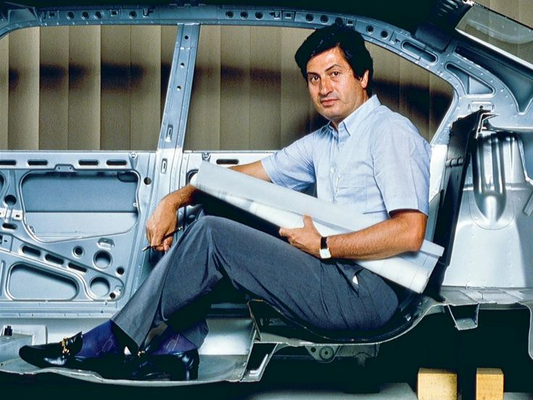Bugatti is today one of the most prestigious brands in the automotive industry, symbolizing luxury, performance and a unique artistic heritage.
Founded in 1909 by Ettore Bugatti, the company embodies the harmony between cutting-edge engineering and artistic creativity, a rare combination in automotive history. But to understand this special connection between Bugatti and art, it is essential to delve into the family history and the aesthetic vision that shaped the brand.
The Bugatti family, a breeding ground for artists
Bugatti’s connection to art goes back long before the car brand was founded. The Bugatti family itself was deeply rooted in the world of art. Carlo Bugatti, Ettore’s father, was a renowned cabinetmaker and designer, specializing in furniture and decorative objects. His eclectic style, influenced by oriental and Art Nouveau motifs, marked the avant-garde of European design in the late 19th century.

Furniture signed Carlo Bugatti
Photo credit: https://www.pinterest.fr/pin/428334614577893049/
Remarkably, this penchant for art did not stop there. Ettore's younger brother, Rembrandt Bugatti, was a renowned animal sculptor, famous for his naturalistic depictions of wildlife, often done in bronze. Rembrandt Bugatti gained international fame for his precise and expressive works, exhibited in the most prestigious museums.

Photo credit: https://www.pinterest.fr/pin/22095854414980349/
Thus, the young Ettore grew up in an environment where art and craftsmanship were omnipresent. He inherited this love for beauty and integrated it into his own field: automotive engineering.
The birth of Bugatti Automobiles
In 1909, Ettore Bugatti founded his company in Molsheim, Alsace. From the beginning, he did not just create functional vehicles; he conceived them as true works of art. Bugatti cars were known not only for their performance on the track, but also for their elegance and pure lines. Ettore insisted that each car be a marriage of technology and aesthetics. According to him, a car had to be beautiful in order to function well.

Bugatti Type 13
Photo credit: https://www.pinterest.fr/pin/295478425538239225/
The first model to achieve resounding success was the Bugatti Type 13, which, thanks to its lightness and maneuverability, won numerous races in the 1920s. However, the beauty of its curves and the precision of its mechanical details already set it apart from other racing cars of the time.
Automotive design: an art in motion
Over the decades, Ettore Bugatti's philosophy has allowed the brand to produce cars that combined technical virtuosity with a refined aesthetic. The most emblematic model of this fusion of art and performance is undoubtedly the Bugatti Type 35 , which not only dominated the racetracks, but also seduced with its revolutionary and elegant design.

Bugatti Type 35
Photo credit: https://www.pinterest.fr/pin/302233824966628547/

Bugatti Royal and Jean Bugatti
Photo credit: https://www.pinterest.fr/pin/558798266273902232/
Then came the Bugatti Type 41 Royale , a car designed for the crowned heads and elites of the time. It symbolised grandeur, with its impressive proportions, immense engine and artistic finishes. Produced in extremely limited quantities, the Royale was a true masterpiece of automotive craftsmanship, often compared to a sculpture on wheels.
Jean Bugatti: the artistic heir
Ettore's son, Jean Bugatti , inherited his father's artistic sensibility and took the ambition of merging art and engineering even further. Jean was the creator of some of the brand's most iconic models, including the Bugatti Type 57SC Atlantic , considered by many to be one of the most beautiful cars ever created.

Bugatti Type 57SC Atlantic
Photo credit: https://www.pinterest.fr/pin/71635450309470874/
The Type 57SC Atlantic, with its flowing body and bold lines, was the epitome of the Bugatti philosophy: a car that sacrificed neither performance nor aesthetics. Only four examples were built, and each car remains a priceless treasure for collectors today. Jean Bugatti thus played a key role in strengthening the connection between Bugatti and art.
Bugatti and Modern Art
In addition to its family heritage, Bugatti was also influenced by the artistic movements that marked Europe in the early 20th century, particularly Art Deco . This aesthetic was reflected in the elegant lines, luxurious materials and attention to detail in the design of the cars. At the time, Bugatti cars were often compared to pieces of fine jewelry due to their exquisite workmanship.
This symbiosis between art and technology has never left Bugatti's DNA, even after the tragic death of Jean Bugatti in 1939 and the difficulties encountered by the company after the Second World War.
Bugatti today: the continuity of an artistic vision
Relaunched by the Volkswagen Group in the 2000s, Bugatti has maintained this tradition of artistic and technical excellence. The Bugatti Veyron , and later the Bugatti Chiron , are modern examples of this vision: hypercars that push the limits of speed while embodying luxury, finesse and beauty.

Bugatti Chiron Super Sport “Golden Era”
Photo credit: https://www.pinterest.fr/pin/11962755254673511/
Bugatti’s contemporary design continues to draw inspiration from the heritage of its founders, with meticulous attention to form and materials. Collaborations with avant-garde artists and designers are also frequent, reinforcing the inextricable link between Bugatti and art.
This artistic momentum has never been so important under the Rimac brand, the manufacturer's latest creation, the Bugatti Tourbillon, incorporates all the elements that characterize Bugatti: noble materials, very high-end finish, allowing it to create more than a car, a timeless object of art.

Bugatti Turbillon
Photo credit: https://www.pinterest.fr/pin/346777240261293581/




